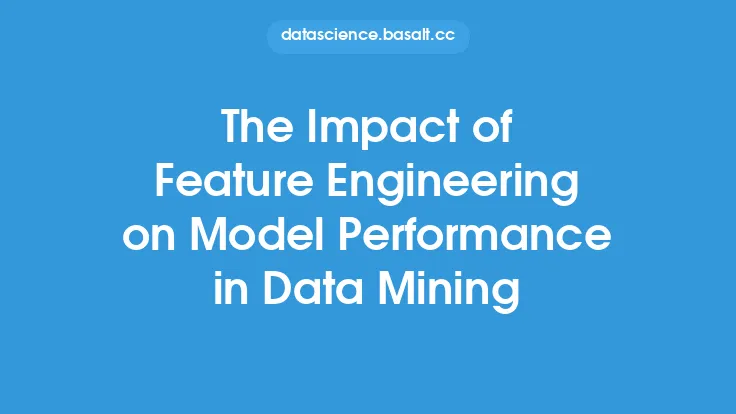Machine learning models are only as good as the parameters that govern their behavior. While model architecture and data quality are crucial, hyperparameters play a vital role in determining the performance of a machine learning model. Hyperparameters are the parameters that are set before training a model, and they control the learning process, such as the learning rate, regularization strength, and number of hidden layers. The process of selecting the optimal hyperparameters for a model is known as hyperparameter tuning.
What is Hyperparameter Tuning?
Hyperparameter tuning is the process of searching for the best combination of hyperparameters that results in the best performance of a machine learning model. This process involves defining a search space, which is the set of possible hyperparameter values, and then using a search algorithm to find the optimal combination. The goal of hyperparameter tuning is to find the hyperparameters that minimize the loss function or maximize the performance metric of the model.
Why is Hyperparameter Tuning Important?
Hyperparameter tuning is essential for achieving good performance in machine learning models. Different hyperparameters can significantly impact the model's performance, and finding the right combination can be the difference between a model that generalizes well and one that overfits or underfits the training data. Moreover, hyperparameter tuning can help to prevent overfitting by regularizing the model and reducing its capacity to fit the noise in the training data.
Types of Hyperparameters
There are several types of hyperparameters that can be tuned, including:
- Learning rate: The step size of each gradient descent iteration.
- Regularization strength: The amount of penalty applied to the model for large weights.
- Number of hidden layers: The number of layers in a neural network.
- Number of units in each layer: The number of neurons in each layer.
- Activation functions: The functions used to introduce non-linearity in the model.
- Batch size: The number of samples used to compute the gradient in each iteration.
- Number of epochs: The number of times the model sees the training data.
Hyperparameter Tuning Techniques
There are several hyperparameter tuning techniques, including:
- Grid search: A brute-force approach that involves trying all possible combinations of hyperparameters.
- Random search: A probabilistic approach that involves sampling the search space randomly.
- Bayesian optimization: A probabilistic approach that involves using a surrogate model to search the space.
- Gradient-based optimization: An approach that involves using gradient descent to search the space.
Challenges in Hyperparameter Tuning
Hyperparameter tuning can be challenging due to several reasons:
- High dimensionality: The search space can be high-dimensional, making it difficult to search.
- Non-convexity: The loss function can be non-convex, making it difficult to optimize.
- Computational cost: Hyperparameter tuning can be computationally expensive, especially for large models.
- Noise in the evaluation metric: The evaluation metric can be noisy, making it difficult to determine the optimal hyperparameters.
Evaluating Hyperparameter Tuning Methods
Evaluating hyperparameter tuning methods can be challenging due to the noise in the evaluation metric. Several methods can be used to evaluate hyperparameter tuning methods, including:
- Cross-validation: A technique that involves splitting the data into training and validation sets.
- Bootstrapping: A technique that involves resampling the data with replacement.
- Monte Carlo methods: A technique that involves using random sampling to estimate the performance.
Real-World Applications of Hyperparameter Tuning
Hyperparameter tuning has several real-world applications, including:
- Computer vision: Hyperparameter tuning can be used to improve the performance of computer vision models.
- Natural language processing: Hyperparameter tuning can be used to improve the performance of natural language processing models.
- Recommendation systems: Hyperparameter tuning can be used to improve the performance of recommendation systems.
- Autonomous vehicles: Hyperparameter tuning can be used to improve the performance of autonomous vehicles.
Future Directions in Hyperparameter Tuning
Hyperparameter tuning is an active area of research, and several future directions can be identified:
- Automating hyperparameter tuning: Developing methods that can automate hyperparameter tuning.
- Using transfer learning: Using pre-trained models to reduce the need for hyperparameter tuning.
- Using multi-task learning: Using multi-task learning to learn multiple tasks simultaneously and reduce the need for hyperparameter tuning.
- Using meta-learning: Using meta-learning to learn how to learn and reduce the need for hyperparameter tuning.
Conclusion
Hyperparameter tuning is a crucial step in machine learning that can significantly impact the performance of a model. While it can be challenging due to the high dimensionality of the search space and the non-convexity of the loss function, several techniques can be used to search the space and find the optimal hyperparameters. Evaluating hyperparameter tuning methods can be challenging due to the noise in the evaluation metric, but several methods can be used to estimate the performance. Hyperparameter tuning has several real-world applications, and future directions include automating hyperparameter tuning, using transfer learning, multi-task learning, and meta-learning.





